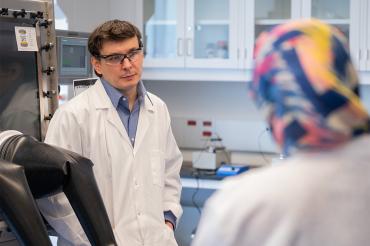AI used to discover clean energy materials 'faster and more efficiently'

Published: February 7, 2023
Researchers at the University of Toronto have developed a method of harnessing artificial intelligence to discover new and more efficient materials for clean energy technology.
A team led by Alex Voznyy, an assistant professor in the department of physical and environmental sciences at U of T Scarborough, used machine learning to significantly speed up the amount of time needed to find new materials with desired properties.
“We are trying to find better alternatives to the materials we currently have,” says Voznyy, whose research looks at developing new materials for lithium-ion batteries, hydrogen storage, CO2 capture and solar cells.
“This could mean developing completely new materials or using materials we already know about but never considered using in clean energy applications.”
Voznyy says a major problem with the materials currently used in clean energy technologies is they are either expensive, inefficient or at the limit of their capabilities. The goal, he says, is to create new and better materials by combining elements of existing ones.
The machine learning model relies on data found in the Materials Project, an open-source database of more than 140,000 known materials developed over the past decade. It contains information about the components of known materials, including crystal structure, molecular composition, density, energy conductivity and stability.
To figure out what combination of existing materials could lead to a better lithium-ion battery, for example, Voznyy says it may require figuring out the stability of the new material and how much energy it can store.
The challenge is that the calculations required to do this work do not scale very well. More complex materials such as an alloy require twice as many atoms to encode, making it four times slower to calculate using conventional methods. Doing these types of calculations currently relies on a quantum chemistry approach that Voznyy refers to as “computing by brute force” because it is slow and uses a lot of computing power.
By contrast, the model developed by Voznyy’s team can do these calculations 1,000 times faster.
“Our philosophy is that we don’t want to spend another 10 years preparing data that will predict the same outcome,” says Voznyy, who runs the Clean Energy Lab at U of T Scarborough.
“We want to be able to predict new materials faster and more efficiently so we can start physically creating these materials sooner and with greater certainty that they will work.”
Previous models were able to reproduce the stabilities of known materials, but they couldn’t predict for materials with unknown crystal structures, which refers to the way atoms, ions and molecules are arranged in a material – an essential factor in determining its physical properties. By training the new model on something called distorted structures, it provides insights into how new materials will perform under strain and allows the model to relax a crystal structure to its more stable configuration.
“Knowing the precise crystal geometry is essential to accurately predicting what the properties of new materials will look like and how they will perform,” says Voznyy. “This method significantly speeds up this process and opens up a lot of possibilities.”
Voznny’s team used Niagara, U of T’s supercomputer located at the SciNet centre, to run the calculations for the study.
The research, which is published in the journal Patterns, was supported by the Natural Sciences and Engineering Research Council of Canada.


